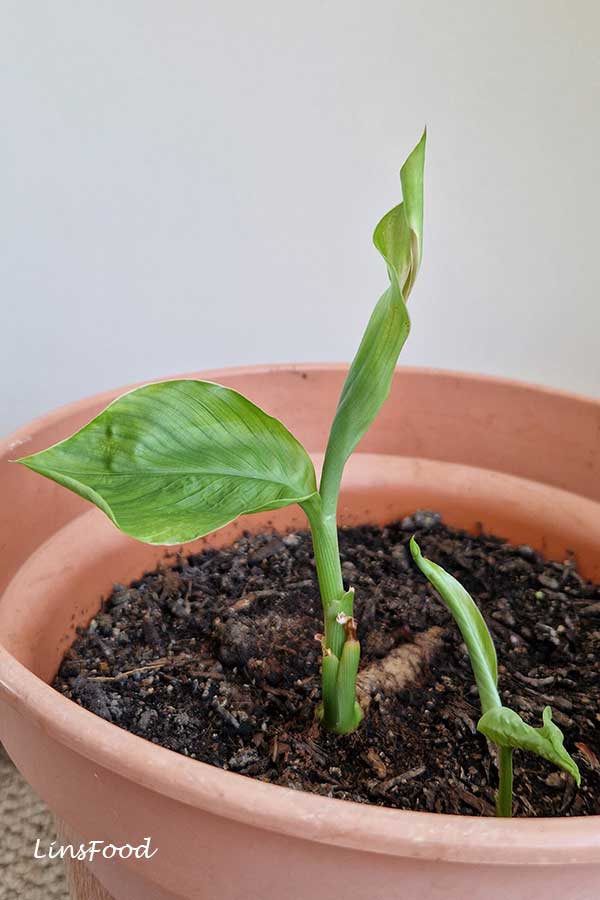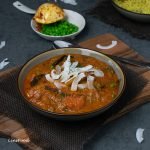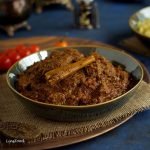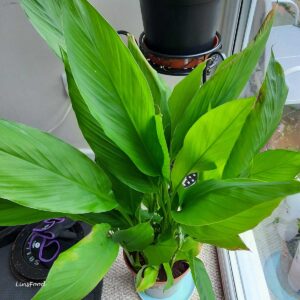Turmeric leaves, known as daun kunyit in Malay, are a crucial ingredient in the making of a Singaporean and Malaysian rendang. Find out more right here!
Estimated reading time: 7 minutes

What are Turmeric Leaves?
Turmeric leaves are the leaves of the turmeric plant, curcuma longa, a member of the ginger family. The plant itself is native to Asia and both its rhizome and leaves are used for cooking, as well as medicinal purposes.
In the last 10 years or so, there’s been a lot of hype associated with turmeric and its health benefits, giving rise to many turmeric based recipes. You can read more about that and get about half a dozen turmeric drinks and smoothies over at LinsFood. Just search for turmeric.
But this article is all about turmeric leaves, so let’s move on, shall we?
Depending on the region, turmeric leaves are also known as:
- daun kunyit in Malay and Indonesian
- haldi ke pette in Hindi
- daun = leaf
- kunyit = turmeric
- pette = leaves (plural of patta)
Want to know how to pronounce kunyit? The first syllable is easy enough, it’s coo. So you have coo – nyate.
For the second syllable, head on over to my Ayam Kapitan YouTube video here, and hit the 0:48 second mark. I sound out the pronunciation of -ny. There is no corresponding sound in the English language for it.
Characteristics of Turmeric Leaves
Turmeric leaves have an elongated, oblong shape. Size wise, they can range from small to pretty large. The leaves shoot up from the rhizome in alternate rows, opposite each other, as you can see from the image and video below. The early, young leaves are small, and as the plant gets bigger, the leaves increase in size correspondingly.
See the old images on this page with my kids holding the leaves when they were much younger. The biggest leaf is probably about a metre long (just over a yard).
Daun kunyit are highly aromatic, with spicy, gingery and citrusy notes, with a tiny touch of lemongrass. But in order to enjoy the aroma, the leaves have to be cut/torn or cooked.
You can consume them raw, they have a grassy flavour with just a hint of bitter upon chewing.

How to use Turmeric Leaves
Turmeric leaves are prized for their aroma, and are widely used in certain parts of South East Asia as well as India, particularly in Goa and Odisha.
In Singapore and Malaysia, turmeric leaves are a must-have ingredient in cooking rendang. You want to cook an authentic Singaporean and Malaysian beef rendang? You need turmeric leaves. Kaffir lime leaves, which many use in their rendang recipes, do not capture the soul of an authentic Singaporean and Malaysian beef rendang, or any rendang for that matter.
Indonesian rendang also uses turmeric leaves along with daum salam (Indonesian bay leaves) and lime leaves.
You can also shred daun kunyit thinly and add to rice, couscous and other grains, as well as to salads and stir-fries, see below.



In India
Turmeric leaves are used in certain parts of India, most notably, for making the Goan patholi (patoleo) and Enduri Pitha from Odisha.
Patholi is made with a ground rice batter, filled with a rich filling made with coconut and jaggery. This is then wrapped in turmeric leaves and steamed.
Enduru Pitha, also known as haldi patra pitha, is fairly similar. The batter here is made with a mixture of black gram and rice flour, while the filling can be jaggery and coconut or jaggery and chenna (Indian cottage cheese). These are then wrapped in haldi leaves and also steamed.
In both India and South East Asia, turmeric leaves are often used as a wrapper for fish before cooking it through steaming, frying or grilling. The leaves give off an amazing scent to the food that is being cooked in them.

How to Grow Turmeric Leaves?
Turmeric leaves are so, so easy to grow. All you need is fresh turmeric rhizomes, warm weather, some compost (or soil) and a medium-large pot or your garden. I always have fresh turmeric at home, and when I leave them long enough, even in winter, they start sending up shoots.
This is what you do:
- Get a pot that’s about 30cm/1 foot wide and high and fill with all purpose compost, mixed with a little perlite, if you have some. Or dig a tiny hole in your garden that will take your small rhizomes.
- Plant 2 rhizomes in your pot, ensuring that about half a cm of it is above the compost surface. You can plant as many as you like in the garden, ensuring at least 10cm/third of a foot between each rhizome.
- Water lightly.
- Then, leave it to its own devices. and before long, depending on the temperature, you’ll see tiny shoots starting to sprout. These are your baby turmeric leaves. In warm weather, water lightly every other day. The compost/soil wants to be wet, but we don’t want too much water as we’ll end up drowning the rhizomes. If it’s cloudy and not too warm, go 3 days between watering.
** be careful of strong sunlight if your pot is sitting next to a window. The leaves will get scorched. - You can start using the leaves whenever you want, but give them a chance to grow at least 15 cm/half a foot.
- At the end of the growing season when the leaves are beginning to brown from the cold, dig it all up. Freeze the leaves and gather the turmeric rhizomes and store them in your kitchen. Fresh turmeric will keep at room temperature easily for about 2 months before showing signs of age. You can also freeze the fresh turmeric.

How to Store Turmeric Leaves?
The best way to store turmeric leaves is to freeze them. Upon defrosting, the leaves will be soft, but their aroma will be completely intact. This is what I do. As soon as my current plant has leaves big enough to film, I shall do a YouTube video about them. In the meantime, I’ve given you an excerpt from an old video in the card below.
You could also store daun kunyit in the fridge. Wrap them up in kitchen paper or even a plastic bag and store in your vegetable box. They’ll last about a week.
Health Benefits of Haldi Leaves
Turmeric leaves share many of the same properties as the rhizome in fresh or dried form. So they can be:
- anti inflammatory
- anti viral
- anti bacterial (South Asians make a paste of the rhizome and/or leaves for acne
- antiseptic
- they also boost digestion
And there you have it, all about turmeric leaves, aka daun kunyit or haldi leaves. Let’s take a look at the rendang recipes on this site, and very briefly, how to prepare turmeric leaves for use.
If you like the article, drop me a comment to let me know. And if you’re feeling like a star, don’t forget that 5-star rating! 😉Thank you!
If you make the recipe, share it on any platform and tag me @azlinbloor, and hashtag it #linsfood
Lin xx
Recipes Using Turmeric Leaves (Daun Kunyit)




How to Use Turmeric Leaves
Ingredients
- 1 large turmeric leaf
- 4 kaffir lime leaves can be used as an alternative they're not substitutes
Instructions
To use in curries, stews, rice and salads
- Rinse and dry the leaf.
- Roll the leaf lengthwise and with a pair of scissors, or a knife and chopping board, cut the turmeric leaf roll thinly. Add to your recipe at the start of cooking or toss in, for salads.You'll see this in the video below.
To use whole
- Rinse and dry the turmeric leaf.
- Snip off the long-ish stalk (petiole) at the bottom of the leaf.
- Lightly grease the leaf and fill as the recipe calls for. Then secure with a cocktail stick or lie your parcel with the seam side down if steaming. If frying or grilling, it's best to secure it with a stick.Don't forget to soak your cocktail sticks in water if grilling (barbecuing).Look out for a fish wrap recipe in a month, as soon as my leaves are large enough!

8 thoughts on “What are Turmeric Leaves (Daun Kunyit) & How to Use Them?”